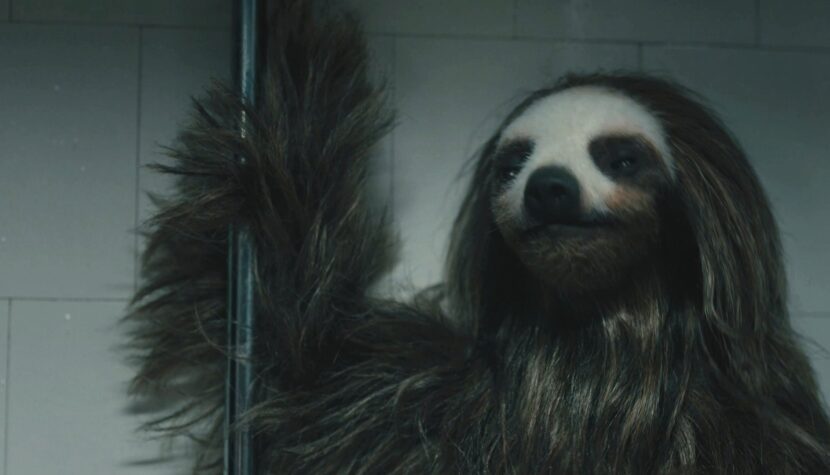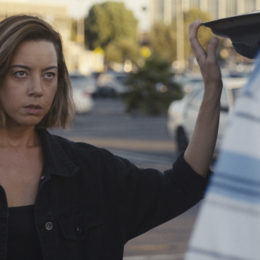SLOTHERHOUSE. Charming massacre [REVIEW]

Have you already seen murderous clowns, dolls, bears, sharks, crocodiles, and even snowmen – but have you ever encountered a bloodthirsty sloth? Well, now you have the opportunity thanks to Matthew Goodhue’s film Slotherhouse. It captures the essence of the film – a slasher in which the perpetrator of bloodshed is an inconspicuous sloth.
We begin by getting to know the furry protagonist, who is a slowly walking sweetness. In Goodhue’s film, however, this turns out to be nothing more than a clever tactic of a ruthless murderer who deceives potential attackers with the appearance of lethargy and a cute snout. In essence, the sloth is the king of the jungle, unchallenged even by crocodiles, literal death machines. If such a creature (the sloth, not the crocodile) falls into human hands, trouble is ready – and that’s exactly what happens in Slotherhouse. The titular creature is ruthlessly abducted from its natural environment by poachers, only to end up with an exotic animal dealer and, through him, into the hands of Emily, an unsuspecting college senior dreaming of becoming the president of her sorority. The sloth is supposed to help her in this – a cute creature designated as the mascot of the female association, meant to ensure Emily likes and popularity, essential for overthrowing the current leader, the arrogant and conceited Brianna.

As you can see, the plot is not overly complex. The school environment – although I would like to see a dormitory like the one where the heroines live – is merely a pretext here to bring together as many young girls as possible in a relatively isolated place so that they can become prey for the deadly sloth. The screenwriter, Bradley Fowler, tries to build some morality around not following the applause of the group and the value of being oneself (Emily is obliged to confront her voice-of-reason friend, we see how she revels in power, and let’s not forget that adopting a sloth is a political marketing ploy), but it is of secondary, or even tertiary, importance. Another moral emphasized in Slotherhouse is more prominent – leave wild jungle animals alone and do not harm them by bringing them into your homes. Because the consequences of this can be lamentable, as Goodhue and Fowler add.
Related:
Since the creators invented a sticky way to transfer the predator sloth from the Panamanian wilderness to an American dormitory, they slowly (pun intended) unfold the bloody spectacle. Unfortunately, they do it too sparingly. When our sloth finally gets to work and slaughters more victims, the film is quite well done. Maybe there’s a bit of a lack of imagination in staging, but Goodhue relies on frequent references so skillfully that the sloth’s murderous frenzy provides some enjoyment. We have references to Psycho, The Shining, Nightmare on Elm Street, Halloween, and even Dario Argento’s films – take your pick. However, action sequences are quite thinly spread throughout the narrative and interspersed with overly extended parts of generic exposition. It is so absurd that a few days after the sorority mascot starts killing its members one by one, as if nothing happened, a party is going on, and the killed girls apparently just lie in their rooms. The screenwriter tries to awkwardly patch it up, but in the end, it seems like both the writer and the director are waving it off. It’s a pity for such negligence – creeping in more than one place – because it drags Slotherhouse down significantly and spoils the joy of those more outrageous moments in which the sloth demonstrates not only ingenuity worthy of Michael Myers or Freddy Krueger but also surprising abilities in logical reasoning and handling social media.

Here, I think I’ve touched on the creators’ key problem in Slotherhouse – they included so many elements in the film that they probably couldn’t decide which one to focus on. Should the film run on the engine of a teen drama with a moral lesson, or rather an ecological hyperbole? Should it scare or lean towards parody? Should it be a pure slasher, or an eccentric one in which a Panamanian sloth engages in an Instagram game with teenagers? And I haven’t even mentioned the side plots, such as the alcoholic caretaker or the non-conforming friend. If Goodhue had decided to emphasize one of the elements, Slotherhouse could have turned out quite solid, unpretentious horror cinema. Especially since the practical animation of the sloth is downright wonderful, with all the clumsiness of movement and kitschiness of expression. However, what we get sums up to be just a correct, at times enjoyable monster movie that, yes, can make you laugh, but it’s rather difficult to feel the shivers. I see some similarities to Cocaine Bear, not only because both are animal attack movies but also because both films stay somewhere halfway, not allowing themselves to fully unleash their potential. Well, maybe another animal will give us what the bear and the sloth couldn’t. Maybe a koala?





